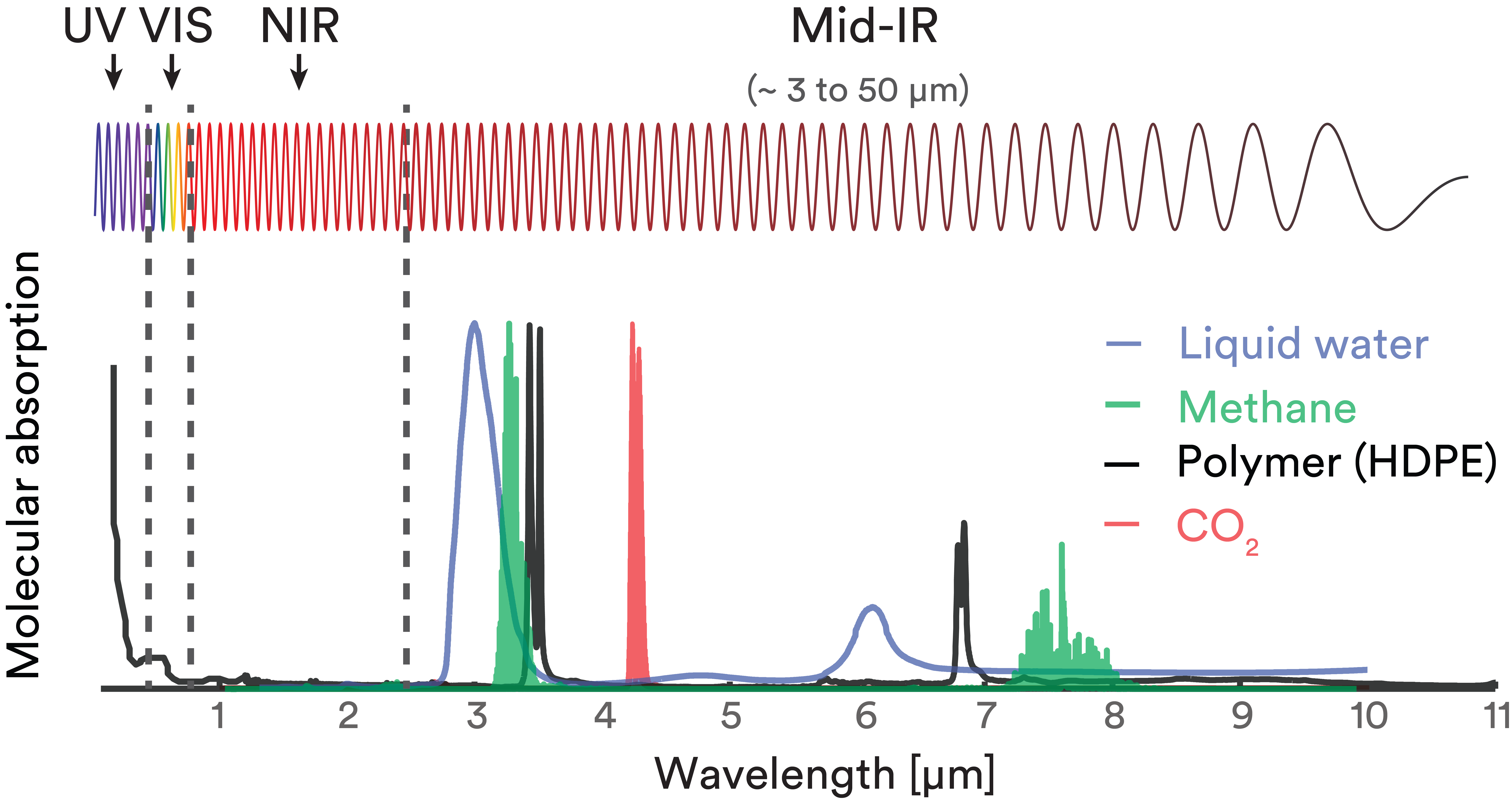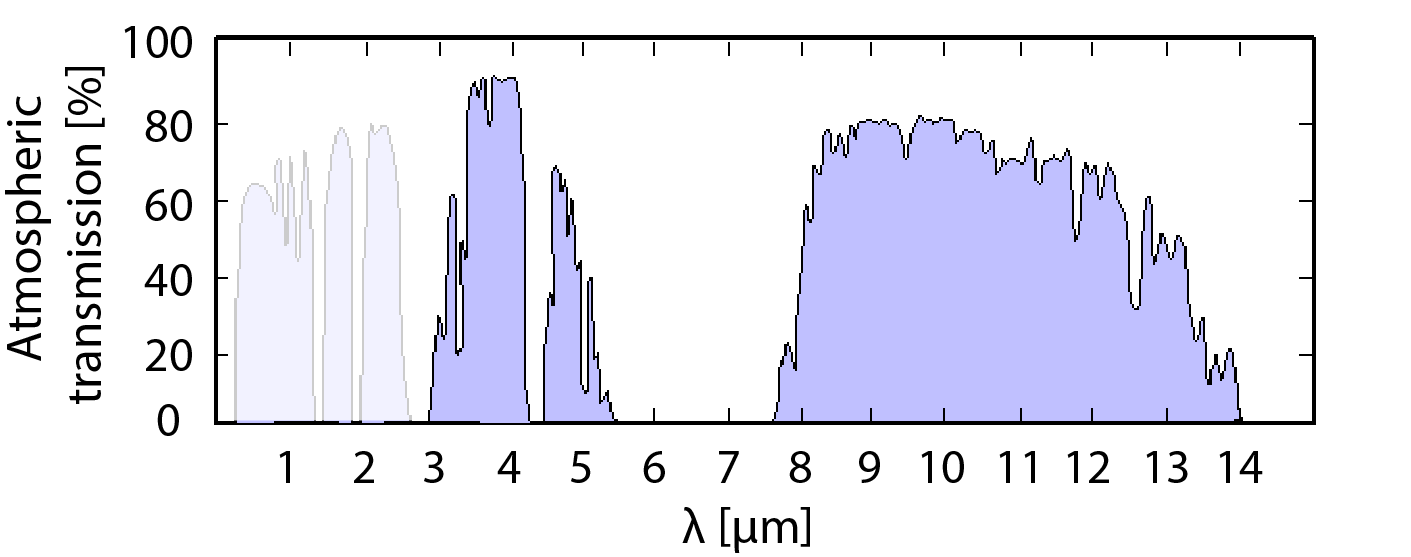The mid-infrared (mid-IR) spectral region is still unfamiliar for most laser users since only few lasers are commercially available in this wavelength range. Recently, new compact and versatile mid-infrared lasers were developed and pave the way for breakthrough applications in industry, science, healthcare and environment.
What is the mid-infrared ?
According to ISO standard (ISO: 20473:2007)1, the mid-infrared is a portion of the electromagnetic spectrum that covers wavelengths from 3 to 50 µm. This spectral region is often separated in two sub-regions, the mid-wave infrared region (MWIR), extending from 3 to 8 µm, and the long-wave infrared region (LWIR), extending from 8 to 15 µm.
Why mid-infrared lasers ?
Lasers are now extensively used for material processing, surgical procedures, telecommunication, spectroscopy, defense applications and fundamental sciences. Mid-infrared lasers are increasingly attractive for research and industry since they offer unprecedented advantages in all these fields of applications. Here is why:
Mid-IR lasers can be selectively absorbed by materials or molecules
The mid-IR is where fundamental vibrational resonances of most liquids, gas and non-metals like plastics, glasses or biological tissues are found. Figure 1 shows that the strong absorption bands of water, methane, CO2 and polymers are mostly located in the mid-infrared. When the emission wavelength of a mid-IR laser overlaps with these resonances, the light is selectively absorbed by those materials or molecules. A better absorption means better control, precision, efficiency and speed for surgical & material processing applications or better selectivity and signal-to-noise ratio for spectroscopy and microscopy.
Lasers with fixed or tunable wavelengths in the mid-infrared thus find serious applications in infrared spectroscopy2 including environmental gaz monitoring3 and breath analysis4 as well as in microscopy5, minimally invasive laser surgery6 and non-metal laser processing (cutting, drilling, surface treatments, etc.). As compared to UV absorption, selective ablation in the mid-IR can play a major role in laser processing of multilayer devices in the electronic, photonic or medical industries, where it is important to process a particular layer without affecting the other adjacent layers.

Mid-IR lasers can be transmitted over large distances in the atmosphere
The mid-IR also contains two major atmospheric transmission windows (3-5 µm and 8-12 µm regions), where there is very low absorption by the main constituents in the atmosphere, as shown in Figure 2. Lasers in these spectral windows can be propagated over long distances, enabling several applications in defense (e.g. missile countermeasures7) and in free-space communications8.

Mid-IR lasers are the ideal scientific tools
Mid-IR lasers also figure as ideal laboratory tools for scientific applications including nonlinear optics, silicon photonics, quantum optics10, high field physics11, frequency combs12 and supercontinuum generation13. These advanced applications will certainly lead to exciting new laser discoveries that will be translated to real-world applications.
If you have other applications in mind or if you want to learn more about how Femtum fiber lasers can help you in your mid-infrared applications, feel free to contact us!
References:
[1] ISO 20473:2007, Optics and Photonics – Spectral bands
[2] J. Haas and B. Mizaikoff, “Advances in mid-infrared spectroscopy for chemical analysis”. Annual Review of Analytical Chemistry, 2016, vol. 9, p. 45-68.
[3] F.K. Tittel, “Mid-infrared Laser Based Gas Sensor Technologies for Environmental Monitoring, Medical Diagnostics, Industrial and Security Applications”, In Terahertz and Mid Infrared Radiation: Detection of Explosives and CBRN (Using Terahertz), 2014.
[4] B. Henderson et al., “Laser spectroscopy for breath analysis: towards clinical implementation”, Applied physics B, 2018, vol. 124, p. 1-21.
[5] M. A. Pleitez et al., “Label-free metabolic imaging by mid-infrared optoacoustic microscopy in livings cells”, Nature biotechnology, 2019, vol. 38, p. 293-296.
[6] S. Amini-Nik et al., “Ultrafast Mid-IR laser scalpel: Protein signals of the fundamental limits to minimally invasive surgery, PLOS ONE, 2010, vol. 5, p. e13053.
[7] J. Hecht, “Photonic Frontiers: Laser countermeasures: scaling down mid-IR laser countermeasures for smaller aircraft”, Laser focus world, 2014.
[8] N. S. Prasad, “Optical communications in the mid-wave IR spectral band”. In: Free-space laser communications. Optical and fiber communications reports, 2005, vol 2, p. 347-391.
[9] Infrared windows
[10] L. M. Rosenfeld, “Mid-infrared quantum optics in silicon”, arXiv:1906.10158, 2019.
[11] T. Popmintchev et al., “Bright coherent ultrahigh harmonics in the keV X-ray regime from mid-infrared femtosecond lasers.”, Science, 2012, vol. 336, p. 1287-1291.
[12] A. Schliesser et al., “Mid-infrared frequency combs”, Nature Photonics, 2012, vol. 6, p. 440-449.
[13] L.R. Robichaud et al., “High-power supercontinuum generation in the mid-infrared pumped by a soliton self-frequency shifted source”, Optics Express, 2020, vol. 28, p. 107-115.
